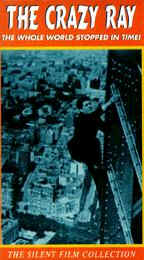 |
Paris Qui Dort The Crazy Ray |
Rene Clair was a French avant-garde filmmaker who is best known for his creative use of satire and for the surrealist qualities of his films. Crazy Ray(1924), also named Paris qui Dort was an experimental film in the sense that it experimented with one specific aspect of film and displayed how the manipulation of that aspect affected the characters of the film. Crazy Ray is similar to a modern dramatic film and is much less experimental than Clair's second film Entr'Acte (1924) or many other avant-garde films of that time. Though Crazy Ray has a strong literal narrative, it employs experimental methods to create cinematic invention.
Clair was inspired to question modern everyday life and the social, economic and physical constraints. This theme exists in many of his films and is artfully depicted within the city of Paris. In Entr'Acte, Clair captures upper class Parisians hopping and running in a funeral procession to discredit and ridicule the bourgeoisie. He created the surreal tones of this film through the alternation of different film speeds, directions and shots. In Crazy Ray, Clair uses these techniques to experiment with concept of time and a film maker's ability to manipulate time and to stop time all together.
The concept of time is of course a recurring theme throughout dada art. The image of the clock itself is symbolically split, destroyed or altered. Clair employs this convention by showing the large city clock halted at 3:25. This immediately reminds the viewer that the common metric to organize everyone's life has been removed. As a result, many figures have been frozen mid-movement. These captured instances are absolutely beautiful. They are realistic and poignant, filled with details and anticipation. A chase scene is paused and for a moment, the theft is without consequence. A suicide is delayed, and perhaps prevented by one character's actions. After Clair demonstrates the arrest of time and the suspension of characters, he goes on to manipulate the direction and speed of time.
Clair uses accelerated motion, slow motion and reverse motion to believably manipulate time. To make these manipulations realistic, Clair does not limit the movement to people. He uses several shots of traffic and city life edited together to create an overall image of the city. He combines the effect of paused images and moving images to illustrate the transition from the still life of stopped time to the movement of normal time. He reverses or accelerates these scenes and inter cuts images of people moving very quickly, slowly and backwards.
Essentially, Clair is depicting a world in which the constraints of time can be altered to affect people and happenings. In the film, this is accomplished by the work of a mad scientist. In the real world, Clair as filmmaker succeeds in halting and restructuring time. Like the scientist, Clair understands that through film, he has the ability to temporarily liberate people from their social classifications, to alter their relationships and to change the outcome of events.